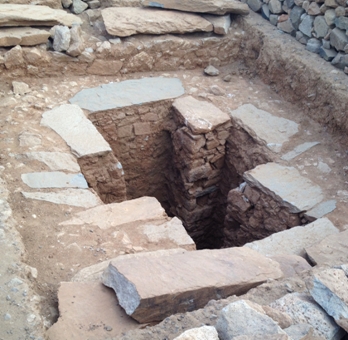Days 3 and 4 in Rosie Sells’ wonderful Ethiopian Diary, detailing Easter Sunday in Gheralta and Axum. For days 1 and 2, click here.
20th April, Easter Sunday: Easter service and drive to Axum
On Easter Sunday we woke up to the breathtaking surroundings of Gheralta Lodge, where we had stayed that night. Individual circular lodges, camouflaged in their setting, were positioned facing out towards a stunning landscape. It was in this setting that we held our Easter Sunday service having climbed to a high and isolated position. As we took communion the vast plains which had been particularly effected by famine in earlier years stretched out before us. The significance of the moment was not lost.
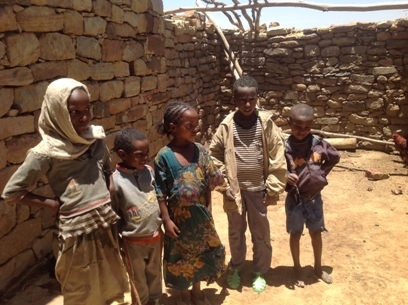
After the service we embarked on another lengthy bus journey, this time to Axum. We made several pit stops along the way, but the most impromptu stop also proved to be the most enlightening. Totally unplanned, our vehicles pulled up on the road and we were ushered into the home of a very obliging family of seven. After hour upon hour of passing these people and their homes, it could not have been a more satisfying moment finding out exactly what goes on behind closed doors.
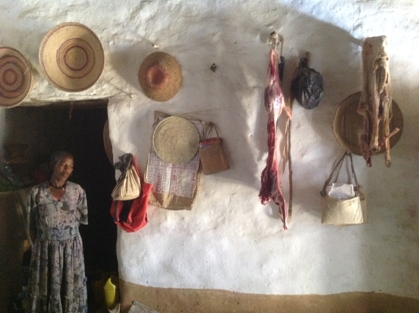
Within the stone walls was an outdoor enclosure, one part open in the centre and the outer area covered. Through this was the indoor area, which had a main room and a smaller one in the corner. A tethered calf and a free ranging chicken were held in the outdoor enclosure, and the remnants of their Easter feast were left out on a short wall which cordoned off a secluded cooking corner. The man of the house welcomed us into the inside area and showed us an array of dried and hanging meat adorning the walls of what was also their bedroom. Woven mats and other wall hangings decorated their home which he proudly presented to us, while his wife stood guard, slightly more sceptical of the intrusion.
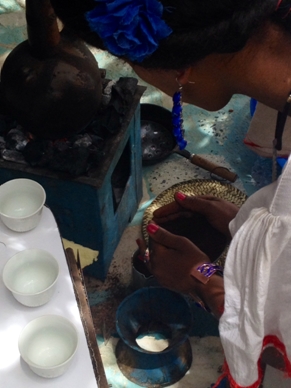
Our journey continued with astounding views of the Adwa mountains, the historic site of the Battle of Adwa in 1896. This was the climactic battle of the first war between the Ethiopians and the Italians which saw Ethiopian victory – although the second was to tell a different story. Before arriving at Axum we also visited the Temple of Yeha. Dating back to around 700BC this Sabean construction is reputedly the oldest standing stone structure in Ethiopia. The precision of the size and shape of the individual stones was remarkable, not to mention that they were positioned on top of each other without any form of adhesive in between. A sacrificial altar stood in the middle, with a drainage system, still intact, which was used to remove the ensuing liquids outside.
21st April, Easter Monday: day in Axum
In store for us today was an action-packed day of ancient constructions and artefacts, historical mysteries and accidental discoveries. Compared to our quiet tour so far, Axum proved to be a hub of tourism and life. We started the day with a walk through the town to the outskirts, to the stelae field and compound of the Cathedral of Tsion Maryam.
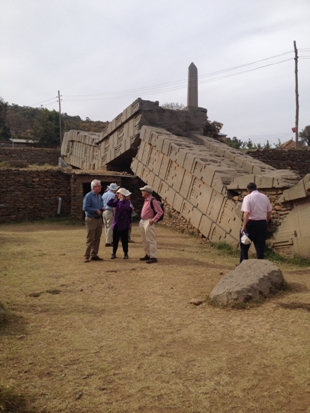
The cathedral compound held a number of historical treasures, although these were obscured by the vast and slightly unattractive new Cathedral of Tsion Maryam built under Haile Selassie in the 1960s. Found behind this, however, was the ruins of Ethiopia’s first church from the 4th century as well as the oldest functioning church, although women were not allowed beyond a certain point to view these. And accessible to no one, the Ark of the Covenant is reportedly held here in a sanctified outbuilding. A small museum commissioned by Haile Selassie’s wife did hold a plethora of ancient artefacts as compensation, including 6th century copy of the Old Testament whose covers were made from wood and pages from goatskin, which lay unprotected and accessible to all on the floor.
Our lunch was navigated by the consensus, learned from previous experience, that sticking to traditional, local, vegetarian food options was by far the best choice. We ordered a full house of injera and chickpea sauce. Injera, the Ethiopian pancake-like bread is characterised by a spongey texture, lemony taste and dubious grey colour. This complemented the mildly spicy chickpea sauce, which was served in a ceramic pot to keep it bubbling hot, and poured into the centre of the injera to be scooped up in a handful of injera. While we ate, a beautiful Ethiopian woman performed a coffee ceremony before us. After cooking the coffee beans over a small stove, pausing occasionally to fan the embers, she passed the beans around for us to examine and smell. These were sent inside to be ground. Meanwhile she boiled the water and burned incense creating a thick, heady aroma.
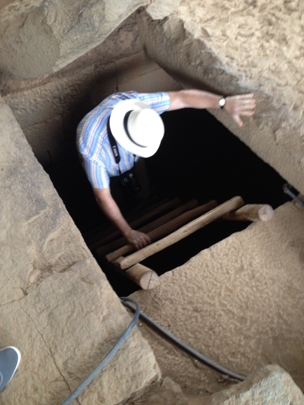
Despite a variety of our group struck down with differing maladies – all part of the experience – we set off to see more of the sites Axum had to offer us. We returned to the stelae field where entire pieces of stone, the largest having been 33m tall, formed these tall structures with sacrificing platforms at the base. We were taken down to the tombs below, which also highlighted the precision of the stone cutting and the phenomenal construction held together without any mortar. We zig zagged across Axum to what is believed to be the Queen of Sheba’s palace, excavated in the 1960s, then past her swimming pool, the Mai Shun reservoir, and further afield to the tombs of Kaleb and gelable carved into the rock.
Many of the discoveries in Axum were the result of complete accident, and discoveries are still being made. Only two months ago in this area a bus had created a divot in the ground which subsequently revealed a remarkable, deep, well-like feature in the shape of a cross, clearly related to the nearby tombs, but that connection is a story yet to be determined.
